Comparison of Emergency Response Abilities and Evacuation Performance Involving Vulnerable Occupants in Building Fire Situations
Abstract
1. Introduction
2. Literature Review
2.1. Risk Factors to the Vulnerable Population during Fire Exposure
2.2. Evacuation Behaviors in Vulnerable Populations
3. Method
3.1. Emergency Response Abilities among Vulnerable Evacuees
3.1.1. Participants
3.1.2. Material
3.2. Evacuation Performance among Vulnerable Occupants
3.2.1. Model Description
3.2.2. Model Variables
- if agent i’s behavior is normal;
- if agent i’s behavior is investigating;
- if agent i’s behavior is evacuating at walking speed if agent i’s behavior is evacuating at accelerated speed.
3.2.3. Simulation Settings
4. Results and Discussions
5. Conclusions
Author Contributions
Funding
Conflicts of Interest
References
- Oppenheimer, M.; Campos, M.; Warren, R.; Birkmann, J.; Luber, G.; O’Neill, B.; Takahashi, K. Emergent risks and key vulnerabilities. In Climate Change 2014: Impacts, Adaptation, and Vulnerability. Part A: Global and Sectoral Aspects; Contribution of Working Group II to the Fifth Assessment Report of the Intergovernmental Panel on Climate Change; Cambridge University Press: Cambridge, UK; New York, NY, USA, 2014; pp. 1039–1099. [Google Scholar]
- The United States Fire Administration (USFA). Fire Risks for Older Adults; The United States Fire Administration: Emmitsburg, MD, USA, 1999.
- National Fire Protection Association (NFPA). People at Risk from Fire. 2018. Available online: https://www.nfpa.org/Public-Education/By-topic/People-at-risk (accessed on 13 January 2019).
- Jenkins, P.; Laska, S.; Williamson, G. Connecting future evacuation to current recovery: Saving the lives of older people in the next catastrophe. Generations 2007, 31, 49–52. [Google Scholar]
- The United States Fire Administration (USFA). U.S. Fire Statistics. 2018. Available online: https://www.usfa.fema.gov/data/statistics/ (accessed on 28 January 2019).
- US Census Bureau. The Population 65 Years and Older in the United States: 2016; American Community Survey Reports; US Census Bureau: Suitland, MD, USA, 2018.
- World Health Organization. Disability and Health. 2018. Available online: http://www.who.int/news-room/fact-sheets/detail/disability-and-health (accessed on 11 February 2019).
- Sime, J.D. Access and egress for the handicapped in public buildings. Build. Des. Handicap. Aged Pers. Int. Inventory 1987, 27, 27. [Google Scholar]
- Ronchi, E.; Nilsson, D. Fire evacuation in high-rise buildings: A review of human behaviour and modelling research. Fire Sci. Rev. 2003, 2, 7. [Google Scholar] [CrossRef]
- Blumer, H. Symbolic Interactionism: Perspective and Method; Berkley, C.A., Ed.; University of California Press: Berkeley, CA, USA, 1969. [Google Scholar]
- Kuligowski, E.D. Modeling Human Behavior during Building Fires; US Department of Commerce: Washington, DC, USA, 2008.
- Breaux, J.; Canter, D.; Sime, J.D. Psychological aspects of behaviour of people in fire situations. In International Fire Protection Seminar, 5th ed.; Brennan, P., Ed.; 1976; Volume 2, pp. 22–24. [Google Scholar]
- Tong, D.; Canter, D. The decision to evacuate: A study of the motivations which contribute to evacuation in the event of fire. Fire Saf. J. 1985, 9, 257–265. [Google Scholar] [CrossRef]
- Mileti, D.S.; Sorensen, J.H. Communication of Emergency Public Warnings: A Social Science Perspective and State-of-the-Art Assessment; No. ORNL-6609; Oak Ridge National Lab.: Oak Ridge, TN, USA, 1990. [Google Scholar]
- Feinberg, W.E.; Johnson, N.R. Firescap: A computer simulation model of reaction to a fire alarm. J. Math. Sociol. 1995, 20, 247–269. [Google Scholar] [CrossRef]
- Bryan, J.L. Behavioral response to fire and smoke. In The Society of Fire Protection Engineers (SFPE) Handbook of Fire Protection Engineering; DiNenno, P.J., Drysdale, D., Beyler, C.L., Eds.; Springer: London, UK, 2002; pp. 315–341. [Google Scholar]
- Purser, D.A.; Bensilum, M. Quantification of behaviour for engineering design standards and escape time calculations. Saf. Sci. 2001, 38, 157–182. [Google Scholar] [CrossRef]
- Kinateder, M.T.; Kuligowski, E.D.; Reneke, P.A.; Peacock, R.D. Risk perception in fire evacuation behavior revisited: Definitions, related concepts, and empirical evidence. Fire Sci. Rev. 2015, 4, 1–26. [Google Scholar] [CrossRef]
- Kholshchevnikov, V.V.; Samoshin, D.A.; Istratov, R.N. The problems of elderly people safe evacuation from senior citizen heath care buildings in case of fire. In Proceedings of the 5th International Symposium “Human Behaviour in Fire”, Cambridge, UK, 19–21 September 2012; pp. 587–593. [Google Scholar]
- Brennan, P. Successful evacuation in smoke: Good luck, good health or good management? In Interflam 1999, Proceedings from the 8th International Fire Science and Engineering Conference; West Yard House: London, UK, 1999; pp. 697–706. [Google Scholar]
- Miller, I.; Davey, J. The Risks, Perceptions, and Experiences of Fire Among Older People. In Fire Research Report; Heimdall Consulting Ltd.: Wellington, New Zealand, 2007. [Google Scholar]
- Canter, D.; Breaux, J.; Sime, J. Domestic, multiple occupancy, and hospital fires. Fires Hum. Behav. 1980, 8, 117–136. [Google Scholar]
- Weick, K.E. Sensemaking in Organizations; Sage Publications: Thousand Oaks, CA, USA, 1995. [Google Scholar]
- Turner, R.H.; Lewis, M.K. Collective Behavior. Englewood Cliffs; Prentice Hall, Inc.: Upper Saddle River, NJ, USA, 1987. [Google Scholar]
- Canter, D.; Donald, I.; Chalk, J. Pedestrian Behaviour during Emergencies Underground: The psychology of crowd control under life threatening circumstances. Saf. Road Rail Tunn. 1992, 135–150. [Google Scholar]
- Kuligowski, E.D. The Process of Human Behavior in Fires; US Department of Commerce: Washington, DC, USA; National Institute of Standards and Technology: Gaithersburg, MD, USA, 2009.
- Klein, G. Sources of Power: How People Make Decisions; The MIT Press: Cambridge, MA, USA, 1999. [Google Scholar]
- Rudolph, J.W.; Morrison, J.B.; Carroll, J.S. Confidence, error and ingenuity in diagnostic problem solving: Clarifying the role of exploration and exploitation. In Academy of Management Proceedings; Academy of Management: Briarcliff Manor, NY, USA, 2007; Volume 2007, pp. 1–6. [Google Scholar]
- CFPA EUROPE. Fire Safety in Care Homes for the Elderly; CFPA-E Guideline No 6:2011 F; CFPA EUROPE: Hvidovre, Denmark, 2011. [Google Scholar]
- Canter, D. Fires and human behaviour: Emerging issues. Fire Saf. J. 1980, 3, 41–46. [Google Scholar] [CrossRef]
- Nilsson, D.; Johansson, A. Social influence during the initial phase of a fire evacuation—Analysis of evacuation experiments in a cinema theatre. Fire Saf. J. 2009, 44, 71–79. [Google Scholar] [CrossRef]
- Kuligowski, E.D. Terror Defeated: Occupant Sensemaking, Decision-Making and Protective Action in the 2001 World Trade Center Disaster. Ph.D. Thesis, University of Colorado, Boulder, CO, USA, 2011. [Google Scholar]
- Day, R.C.; Hulse, L.M.; Galea, E.R. Response phase behaviours and response time predictors of the 9/11 World Trade Center Evacuation. Fire Technol. 2013, 49, 657–678. [Google Scholar] [CrossRef]
- Chu, M.L. A Computational Framework Incorporating Human and Social Behaviors for Occupant-Centric Egress Simulation. Ph.D. Thesis, Stanford University, Stanford, CA, USA, 2015. [Google Scholar]
- O’Neill, M.J. Effects of signage and floor plan configuration on wayfinding accuracy. Environ. Behav. 1991, 23, 553–574. [Google Scholar] [CrossRef]
- Arthur, P.; Passini, R. Wayfinding: People, Signs, and Architecture; McGraw-Hill: New York, NY, USA, 1992. [Google Scholar]
- Akizuki, Y.; Iwata, M.; Okuda, S.; Tanaka, T. Setting Conditions of Signs in Escape Routes by Configuration Factor, Study on Visual Environment Designs for Smooth Evacuation Guidance No. 1. J. Environ. Eng. AIJ 2009, 74, 767–773. [Google Scholar] [CrossRef][Green Version]
- Xie, H. Investigation into the Interaction of People with Signage Systems and Its Implementation within Evacuation Models. Ph.D. Thesis, University of Greenwich, London, UK, 2011. [Google Scholar]
- Saunders, M.; Lewis, P.; Thornhill, A. Research Methods for Business Students, 6th ed.; Pearson Education: New York, NY, USA, 2012. [Google Scholar]
- Choi, B.; Ahn, S.; Lee, S. Role of social norms and social identifications in safety behavior of construction workers. I: Theoretical model of safety behavior under social influence. J. Constr. Eng. Manag. 2016, 143, 04016124. [Google Scholar] [CrossRef]
- Kailes, J.I.; Enders, A. Moving beyond “special needs” A function-based framework for emergency management and planning. J. Disabil. Policy Stud. 2007, 17, 230–237. [Google Scholar] [CrossRef]
- Choi, M.; Lee, S.; Park, M.; Lee, H.S. Effect of dynamic emergency cues on fire evacuation performance in public buildings. J. Infrastruct. Syst. 2018, 24, 04018029. [Google Scholar] [CrossRef]
- The AnyLogic Company Pedestrian Library–Anylogic Simulation Software. 2019. Available online: https://www.anylogic.com/resources/libraries/pedestrian-library/ (accessed on 2 March 2019).
- Lovreglio, R.; Ronchi, E.; Nilsson, D. An Evacuation Decision Model based on perceived risk, social influence and behavioural uncertainty. Simul. Model. Pract. Theory 2016, 66, 226–242. [Google Scholar] [CrossRef]
- Kuligowski, E.D.; Mileti, D.S. Modeling pre-evacuation delay by occupants in World Trade Center Towers 1 and 2 on September 11, 2001. Fire Saf. J. 2009, 44, 487–496. [Google Scholar] [CrossRef]
- Reneke, P. Evacuation Decision Model; US Department of Commerce: Washington, DC, USA; National Institute of Standards and Technology: Gaithersburg, MD, USA, 2013.
- Sherman, M.; Peyrot, M.; Magda, L.; Gershon, R. Modeling pre-evacuation delay by evacuees in World Trade Center Towers 1 and 2 on September 11, 2001: A revisit using regression analysis. Fire Saf. J. 2011, 46, 414–424. [Google Scholar] [CrossRef]
- Gershon, R.; Magda, L.; Riley, H.; Sherman, M. The World Trade Center evacuation study: Factors associated with initiation and length of time for evacuation. Fire Mater. 2012, 36, 481–500. [Google Scholar] [CrossRef]
- Proulx, G. Passengers’ behaviour during an underground evacuation. In Proceedings of the International Conference of the Environmental Design Research Association EDRA-22, Oaxtepec, Mexico, 12–15 March 1991; pp. 118–125. [Google Scholar]
- Proulx, G.; Sime, D.J. To prevent panic in an underground emergency: Why not tell people the truth? In Fire Safety Science-Proceedings of the Third International Symposium; Cox, C., Langford, B., Eds.; Elsevier Applied Science: London, UK, 1991; pp. 843–852. [Google Scholar]
- Withey, S. Reaction to uncertain threat. Man Soc. Disaster 1962, 93–123. [Google Scholar]
- Kobes, M.; Helsloot, I.; De Vries, B.; Post, J.G. Building safety and human behaviour in fire: A literature review. Fire Saf. J. 2010, 45, 1–11. [Google Scholar] [CrossRef]
- Wood, P.G. The behaviour of people in fires. Fire Saf. Sci. 1972, 953, 1. [Google Scholar]
- Heliövaara, S. Computational Models for Human Behavior in Fire Evacuations; Department of Engineering Physics and Mathematics, Helsinki University of Technology: Espoo, Finland, 2007. [Google Scholar]
- Yoo, H. A study on walking velocity of old men in Korean. In Korean Fire Science and Engineering; Korean Institute of Fire Science and Engineering: Seoul, Korea, 2003; pp. 407–414. [Google Scholar]
- Bramble, D.M.; Lieberman, D.E. Endurance running and the evolution of Homo. Nature 2004, 432, 345–352. [Google Scholar] [CrossRef]
- Xu, S.; Duh, H.B.L. A simulation of bonding effects and their impacts on pedestrian dynamics. IEEE Trans. Intell. Transp. Syst. 2010, 11, 153–161. [Google Scholar]
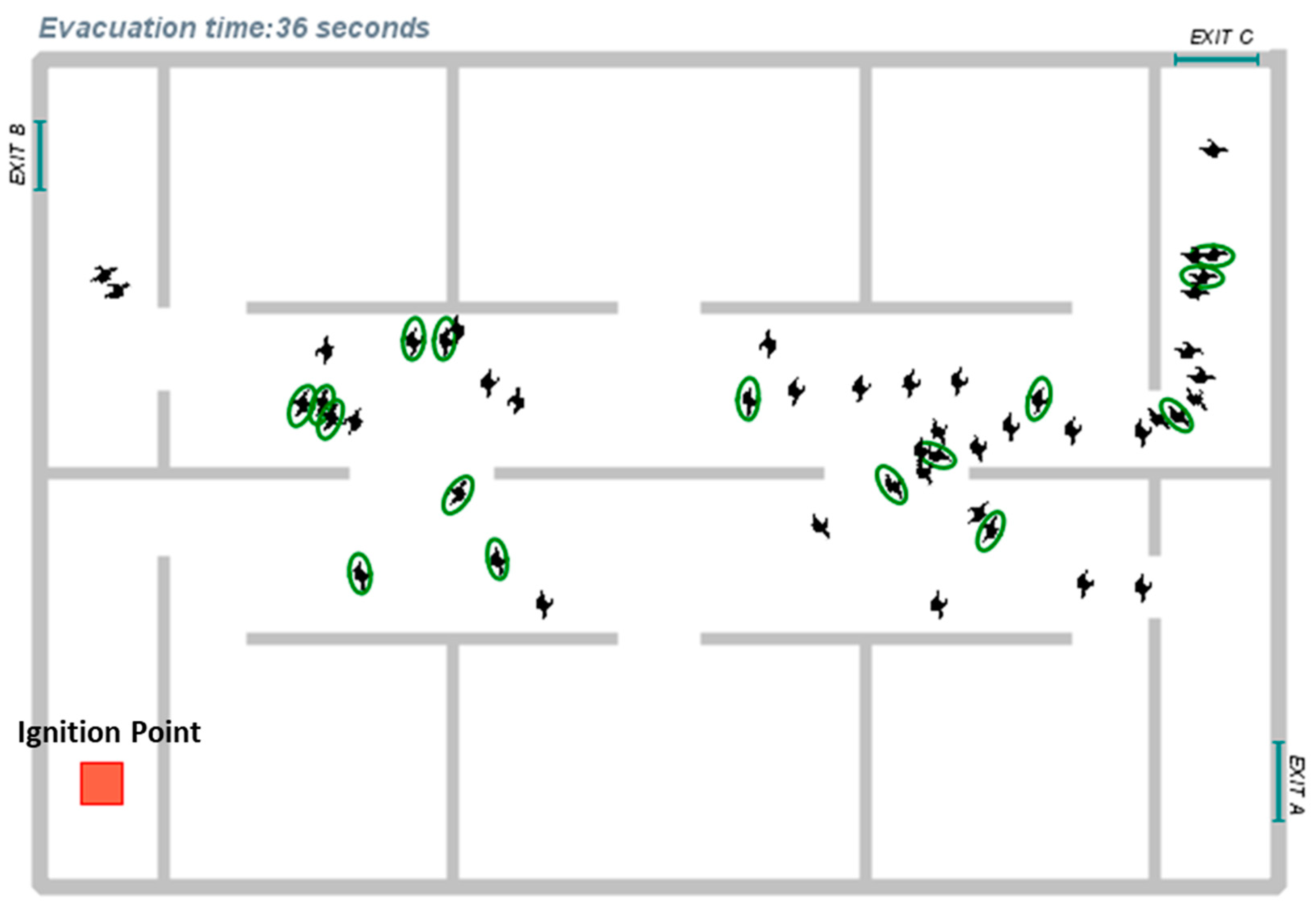
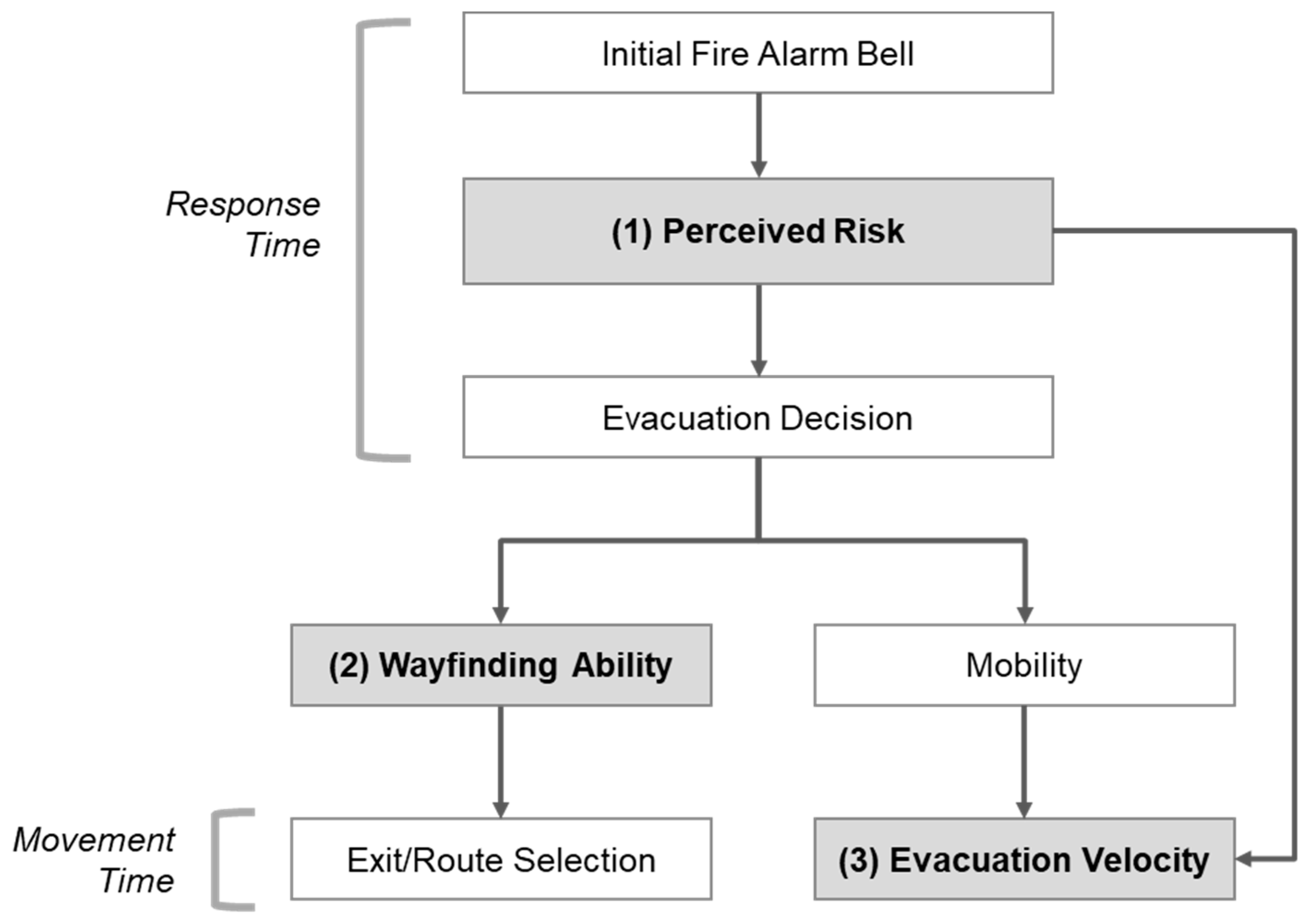
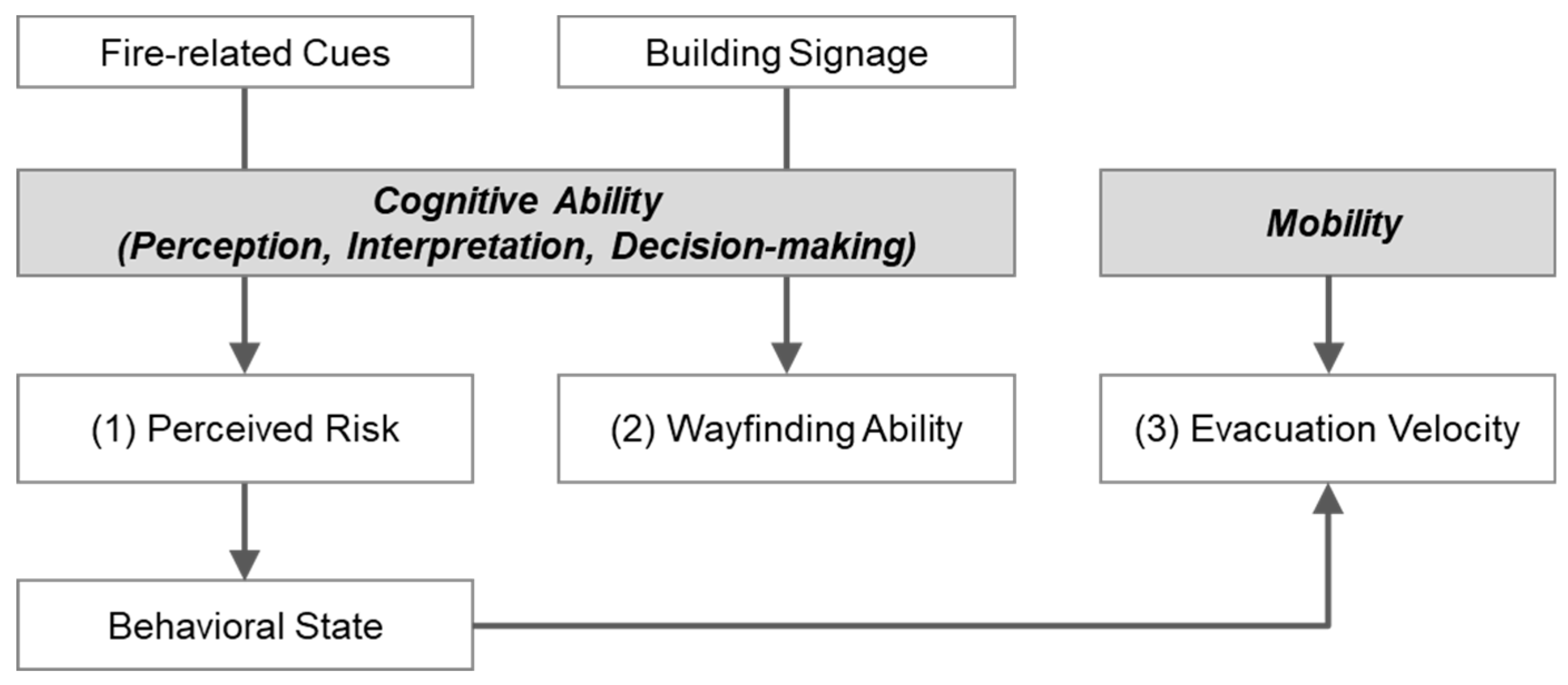
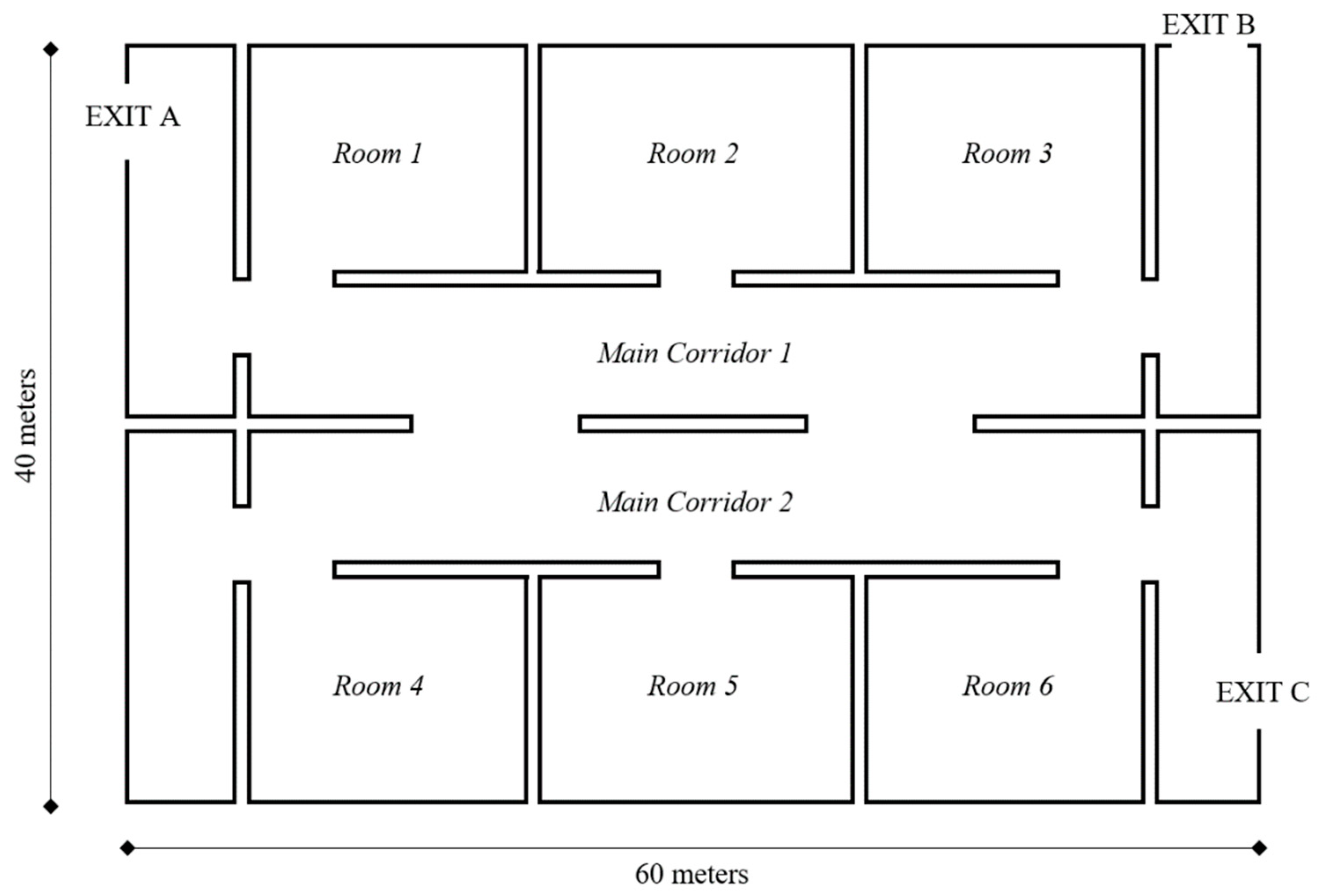
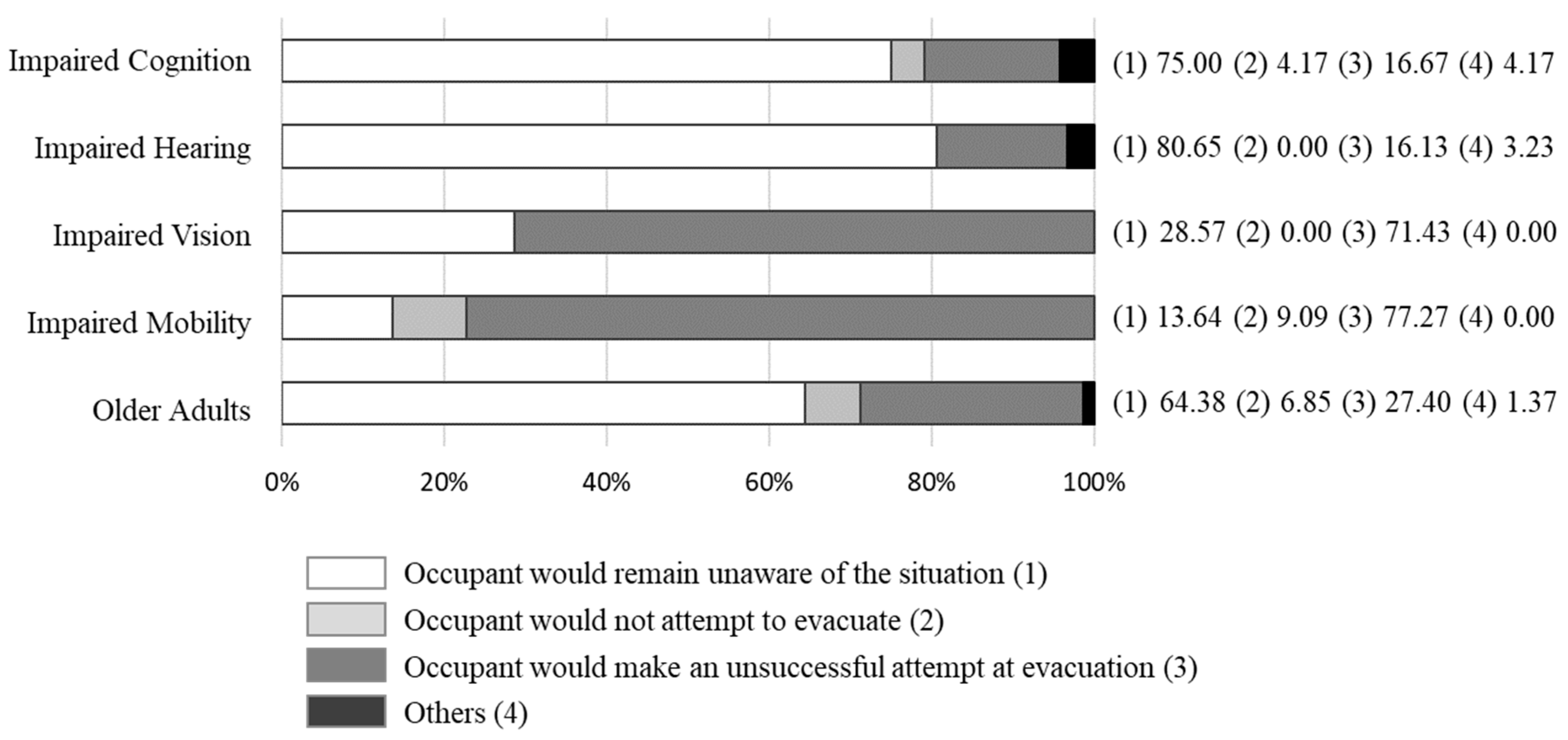


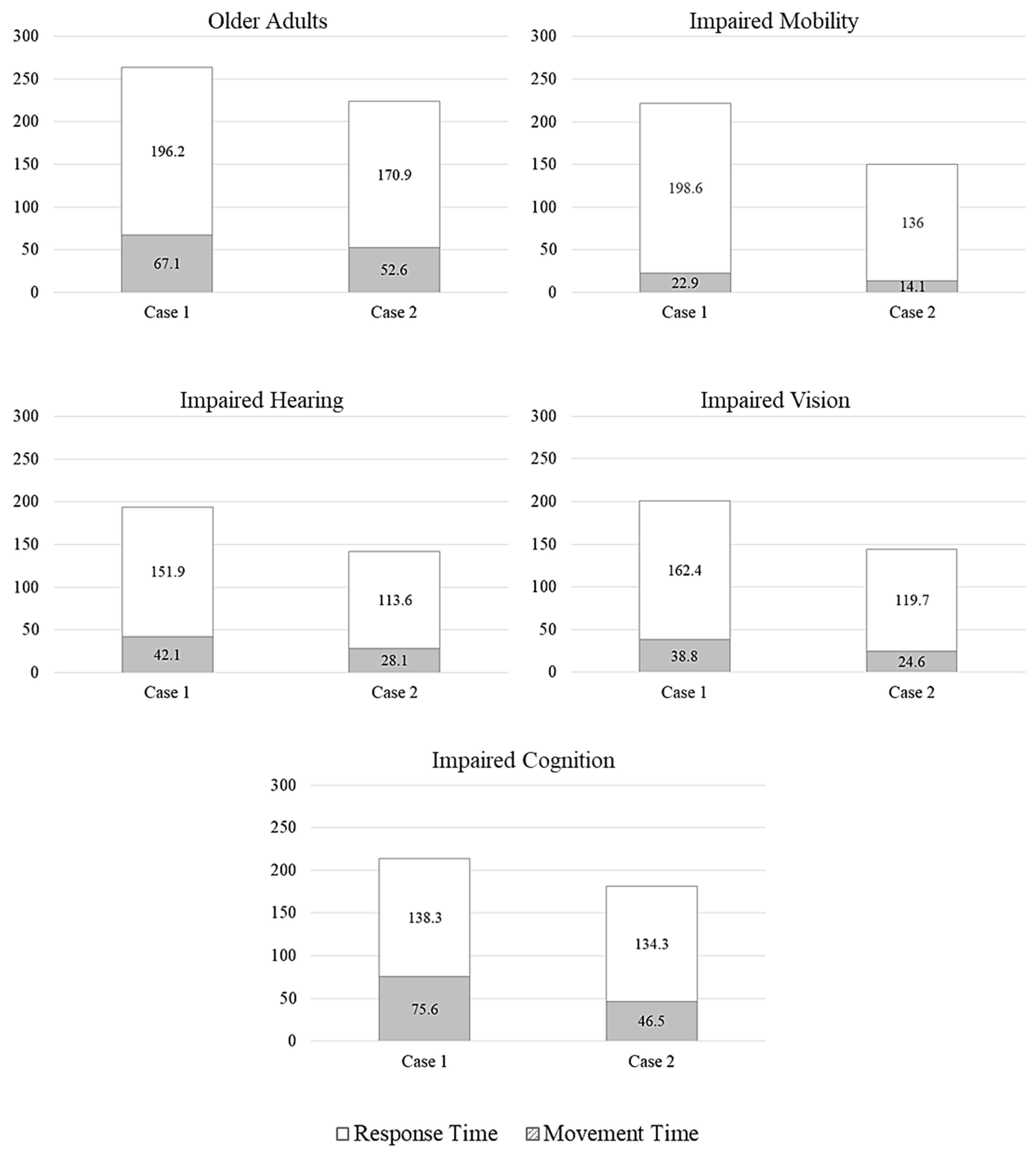
| Type of Healthcare Facility | % of Total Response |
|---|---|
| Healthcare center for the elderly | 41.01 |
| Healthcare center for the cognitively impaired | 17.42 |
| Healthcare center for the mobility impaired | 15.73 |
| Healthcare center for the hearing impaired | 13.48 |
| Healthcare center for the vision impaired | 12.36 |
| Years of Experience in Healthcare | % of Total Response |
|---|---|
| Less than 2 years | 19.66 |
| Between 2 to 4 years | 17.42 |
| Between 4 to 6 years | 18.54 |
| Between 6 to 8 years | 10.67 |
| Between 8 to 10 years | 8.43 |
| More than 10 years | 25.28 |
| Category | Evacuation Ability |
|---|---|
| Perception | Ability to perceive fire-related cues or building signage |
| Interpretation | Ability to understand perceived cues |
| Decision-making | Ability to make the decision to evacuate and choose an available path |
| Mobility | Ability to evacuate without any support |
| Ability to evacuate with support | |
| Ability to evacuate with assistance from staff |
| Agent Attribute | Value Range | Description | |
|---|---|---|---|
| Perception ability | 0 to 1 | Perceived risk | Ability to correctly perceive fire-related cues within a 20 meter radius from current position. |
| Wayfinding ability | Ability to correctly perceive location, path forward, and informative building signage within a 20 meter radius from current position. | ||
| Interpretation ability | 0 to 1 | Perceived risk | Ability to correctly assess perceived risk based on observable fire-related cues. |
| Wayfinding ability | Ability to correctly use prior knowledge of the building and interpret perceived signage to find available routes and exits. | ||
| Decision-making ability | 0 to 1 | Perceived risk | Ability to decide on the appropriate behavioral state based on level of perceived risk. |
| Wayfinding ability | Ability to decide to follow selected route option and egress building. | ||
| Response Level | Behavioral State | Velocity |
|---|---|---|
| 1 | Normal | 0 m/s |
| 2 | Investigating | 0.6 to 0.8 m/s [55] |
| 3 | Evacuating at walking speed | |
| 4 | Evacuating at accelerated speed | 2.3 to 2.5 m/s [56] |
| Perception | Interpretation | Decision-Making | Mobility | |
|---|---|---|---|---|
| Reference Group | 1 | 1 | 1 | 1 (velocity: 0.6 to 0.8 m/s (walking) and 2.3 to 2.5 m/s (running)) |
| Older adults | 0.245 | 0.234 | 0.182 | 0.195 |
| Impaired mobility | 0.693 | 0.727 | 0.645 | 0.309 |
| Impaired vision | 0.546 | 0.639 | 0.407 | 0.325 |
| Impaired hearing | 0.432 | 0.493 | 0.493 | 0.648 |
| Impaired cognition | 0.300 | 0.304 | 0.191 | 0.441 |
© 2019 by the authors. Licensee MDPI, Basel, Switzerland. This article is an open access article distributed under the terms and conditions of the Creative Commons Attribution (CC BY) license (http://creativecommons.org/licenses/by/4.0/).
Share and Cite
Choi, M.; Lee, S.; Hwang, S.; Park, M.; Lee, H.-S. Comparison of Emergency Response Abilities and Evacuation Performance Involving Vulnerable Occupants in Building Fire Situations. Sustainability 2020, 12, 87. https://doi.org/10.3390/su12010087
Choi M, Lee S, Hwang S, Park M, Lee H-S. Comparison of Emergency Response Abilities and Evacuation Performance Involving Vulnerable Occupants in Building Fire Situations. Sustainability. 2020; 12(1):87. https://doi.org/10.3390/su12010087
Chicago/Turabian StyleChoi, Minji, Seulbi Lee, Sungjoo Hwang, Moonseo Park, and Hyun-Soo Lee. 2020. "Comparison of Emergency Response Abilities and Evacuation Performance Involving Vulnerable Occupants in Building Fire Situations" Sustainability 12, no. 1: 87. https://doi.org/10.3390/su12010087
APA StyleChoi, M., Lee, S., Hwang, S., Park, M., & Lee, H.-S. (2020). Comparison of Emergency Response Abilities and Evacuation Performance Involving Vulnerable Occupants in Building Fire Situations. Sustainability, 12(1), 87. https://doi.org/10.3390/su12010087





